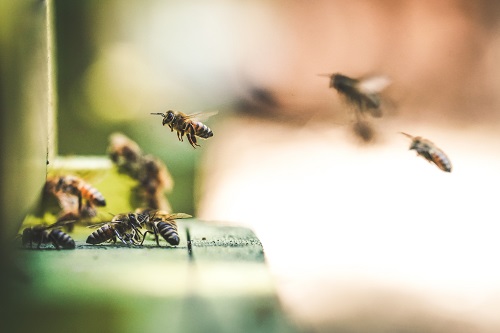Plants With Yellow Flowers to Add to Your Garden
Are you a lover of yellow hues? Yellow is definitely a color that is an instant mood lifter! We always relate yellow with sunshine. Just imagine your garden with yellow flowers giving a happy vibe all day.
It takes a lot of planning for a great-looking garden. Looking for what kind of plants your garden soil will accept while keeping in mind the hardiness of the area you live in and the amount of sun your plants will receive, can be a tedious enough task. Then there’s deciding on the mood and ambiance you want in your garden. Choosing the flowering plants with your desired hues can also be a thoughtful process. While yellow flowers add a cheery lift to your garden, you don’t want to go overboard with the color.
We are going to help you choose just the right golden flowers for your garden. And we promise you that they will be a good investment for your garden in every aspect! So here is a complete guide on plants with yellow flowers to add to your garden.
1. Sunflower
It couldn’t get any more cheerful than having sunflowers in your garden. These wide, daisy-faced flowers are amazingly heliotropic. They move their face with the movement of the sun and then return back as night falls. This phenomenon stops when the flower matures and becomes heavier in size. With their bright yellow petals and brown center that contains the seeds, these flowers are great pollinators that attract birds and butterflies.

There have been rumors in the past for sunflowers being toxic, but no truth to claim this. What we know is that they are completely safe for humans as well as pets.
Care:
Needless to say, these flowers love the sun exposure. In fact, they survive on it! Shelter them from heavy winds and plant them in well-drained soil that doesn’t get clogged up with water. Water once a week unless the weather is extremely dry or hot. They are not at all particular about the pH of the soil. Just feed them with good fertilizers as they are fast-growing plants. Though over fertilizing can have an adverse effect on the plant. You need to give their roots ample space to grow.
Bloom Time:
The annuals bloom from summers into autumn. The perennial sunflowers will bloom for a time period of 8 to 12 weeks.
Here’s a great article on plants that can propagate easily and help you save money.
2. Marigold
Commonly found marigolds are densely packed with yellow to orange petals that have a pungent but attractive fragrance. These are ornamental flowers mostly used for flower beds or edging because of their dwarf size. Marigolds are annual but they do try to grow back from their own seeds as they have the ability to self-seed.
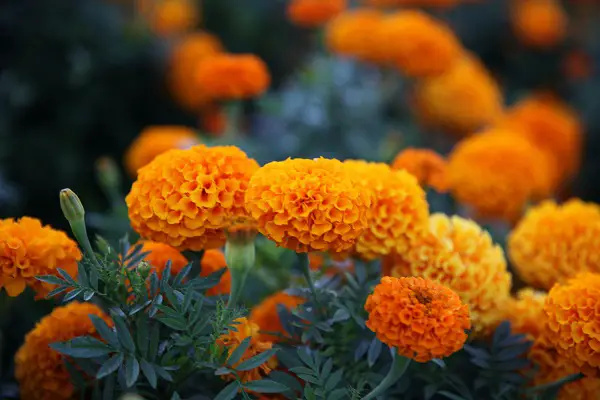
These are not toxic and are considered safe edible herbs commonly used in teas.
Did You Know: Marigolds are planted as companion plants for several vegetables to protect them from pest infestation.
Care:
Water them regularly only when the weather is exceptionally dry or hot. Otherwise, wait for the soil to dry in between watering. Water at the base only as extra moisture can rot the densely packed petal head. Marigolds love full sun but can also do well in part shade. Just give them rich but well-drained soil and they will please you with the results.
Bloom Time:
If all the growing conditions are right for marigolds, they will give you good results by blooming from late spring to fall. They are fast growers as they germinate within days and bloom in the next eight weeks.
3. Dahlia
Dahlias are tender perennials that love the warm temperatures. They go into dormancy in winters. A beautifully fragrant flower with even more beautiful looks, Dahlias come in a variety of colors to choose from. The yellow-colored dahlia will particularly have you in awes with its beauty. It is a show-stopping flowering plant that is very particular about its demands.
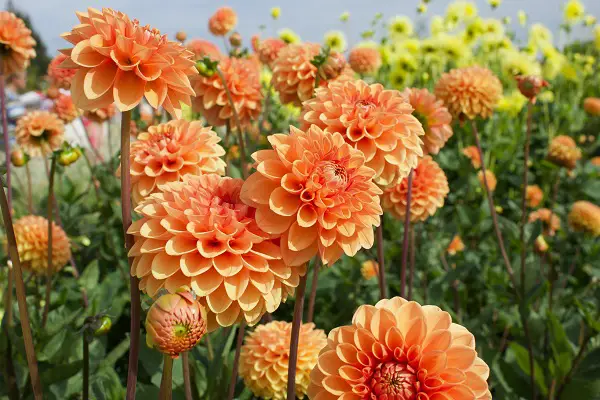
Dahlia is toxic to house pets and they may experience symptoms like vomiting, hypersalivation, and diarrhea.
Care:
Dahlia is a fast-growing perennial flowering bush that needs supplemental energy to thrive in the growing season. They like evenly moist but well-drained soil. These plants grow on tubers so excessive watering rots them. Dahlias like full sun exposure but protect them from wind gusts as that might damage the long stems (for tall varieties).
Bloom Time:
The flowers will bloom in late summers to autumn. They should be planted when the dangers of frost are out of sight. Plant them when the air and soil have warmed up.
4. Lantana
Tiny, delicate flowers growing in clusters, lantana is a tropical flowering plant that is used as flower beds and borders. These are perennials but in cooler climates, they act as annuals. These are neglect tolerant plants that attract a lot of butterflies for pollination. Lantanas are found in a wide range of colors which include a very soft hue of beautiful yellow. Sometimes the yellow is merged with another hue of pink which makes it stand out more. You can grow lantanas in containers as well.
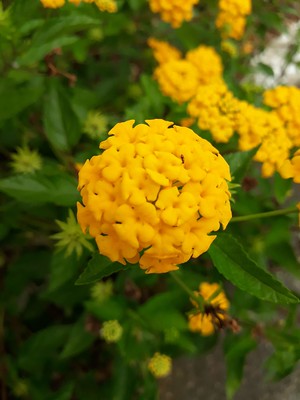
Lantana is a toxic plant, which is poisonous to livestock, pets, and children.
Care:
Never over-water lantanas as they are prone to root rot. Only water when the topsoil is dry. Lantana does well in part shade but loves full sun exposure. Also, the flowering of the plant gets affected by the amount of sun exposure you give them. But lesser sun results in lesser flowers and more pest infestation. Don’t overcrowd the space where you grow them as they need plenty of air circulation. These plants should be regularly fertilized with a slow-release formula.
Bloom Time:
These jolly flower bunches bloom continuously from late spring till the frost. And in warmer regions, they bear flowers all year long.
Turn your dull, grey winter garden into something beautiful with these 10 types of trees you can grow in your garden if you live in cold weather areas.
5. Poached Eggplant
A white and yellow cup-shaped, flower-bearing tree that reminds you of poached egg and hence the name. You have to admit that you can’t keep yourself from smiling once you catch the glimpse of this flower. Best for flower beds and edging because of its size, it is a great companion plant for your vegetable patch as it keeps away insects predators and attracts a lot of pollinators. It is an annual plant but due to the immense production of seeds, it is also categorized as perennial. If you have harsh winters then you need to protect your poached eggplant with a covering.

The poached eggplant has had no toxic effects reported until now. So it is a safe plant to keep around kids and pets.
Care:
These friendly flowers need their full sun exposure. These plants may falter when they are subjected to extreme heat and humidity as well as to frost. Poached eggplants like rich and well-drained soil. So fertilize or compost the plants heavily when they stop blooming.
Bloom Time:
It can grow in poorly drained soil as well. Sow them at any time of the year and they will flower accordingly.
6. California Poppy
Perennial in nature, the California poppy is the state flower of California. With their beautiful deep yellow cupped flowers, they will bring a lot of pollinators to your garden. Because of its cheerful yellow color, it is also sometimes called “cup of gold” or “California sunlight”. It usually grows in the wild alongside the roads and is very popular amongst gardeners for growing in the house yards. You can grow them in containers as well as flower beds. However, those grown in containers in hot areas are classified as annuals because they are short-lived. Other than yellow and orange, they come in a variety of colors including red, pink, and white.
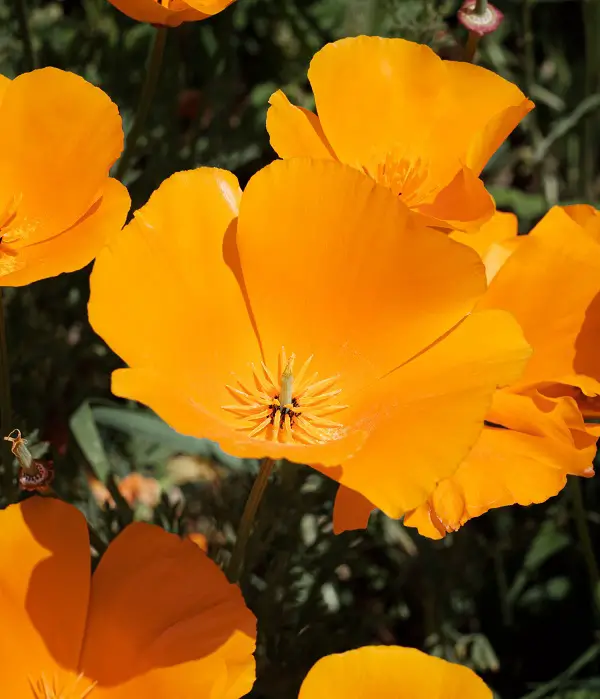
Just be careful with pets and kids around the house as these plants are toxic in nature.
Care:
Less is more when it comes to watering and fertilizing your California poppies. Just give them the conditions they get in their natural habitat. Deadheading the dead flowers may result in more flowering. These plants need full sun exposure for 5 to 6 hours. Lesser sun exposure might result in less flowering and pest infestation. Moderate humidity and temperature are ideal for their growth. California poppies can grow in poor soil with less watering.
Bloom Time:
Whether they are planted in a container or flower beds, these fast-growing flowers will spring up once the weather starts to get warm which is mostly early summers.
Here is our step-by-step guide on how to grow and propagate Pothos plants if you are a fan of these beautiful plants with heart-shaped leaves.
7. Nasturtium
A fun and cheerful flowering plant to grow in your own yard, nasturtium is edible and is used in salads because of its pepper-like taste. While giving your yard a cottage-y vibe, these can be great companion plants for your vegetable patch. Nasturtiums are known as a trap crop, as they attract bugs in the vegetable garden and do not let them near the crops. They can act as climbing vines as well as sprawling flower beds with their beautiful yellow-orange, buttercup-shaped flowers with a sweet fragrance. Nasturtiums are cool-season annuals that hardly survive in hot summers.
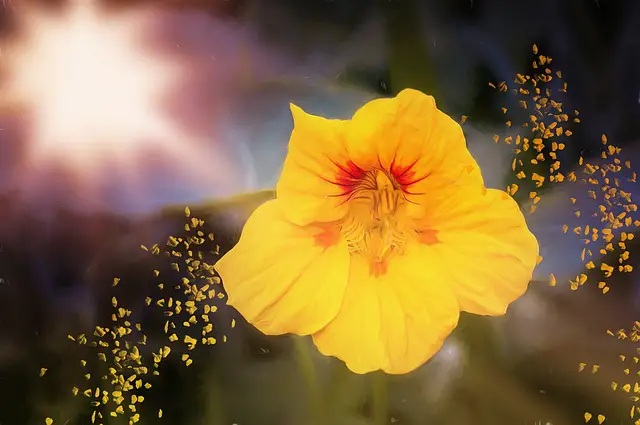
Care:
Water your Nasturtiums regularly (around one inch per week). They will eventually stop producing flowers if kept dry for too long. Deadheading is very healthy for the plant as it gives more space to the new flowers to come. Needless to say, they need full sun exposure of 6 to 8 hours for best results. Do not fertilize them as over-fertilizing will produce more leaves and lesser flowers. Only mulch the soil to keep the weeds away.
Bloom Time:
If you want them to bloom in early summers, then plant them just after the last spring frost. For temperate areas, you can plant them in fall to bloom in winters (remember that these areas do not have harsh winters).
So what are you waiting for? Take your pick for the friendliest yellow flowers and make your garden the envy of the whole neighborhood.

